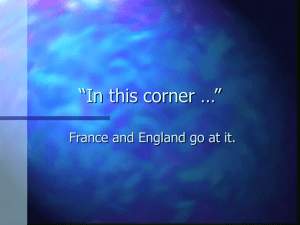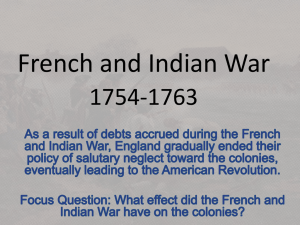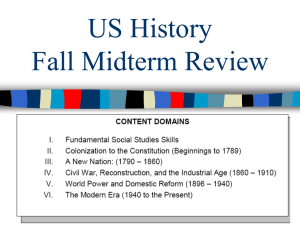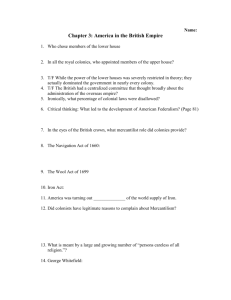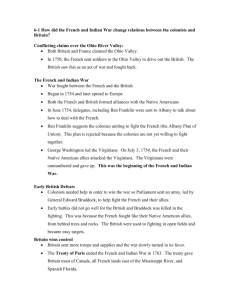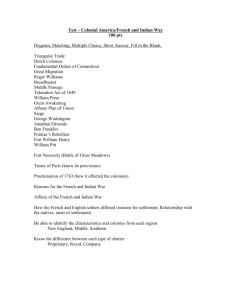French and Indian War and the End of Salutary Neglect 1754-1775
advertisement
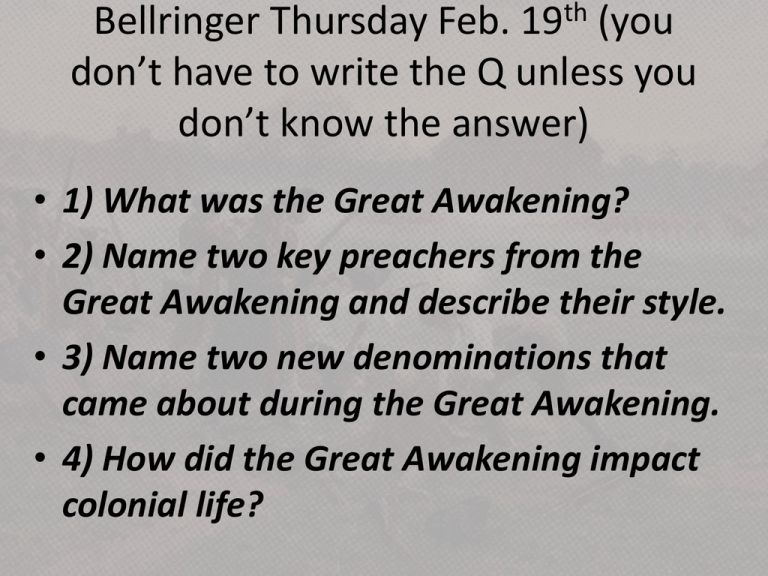
Bellringer Thursday Feb. 19th (you don’t have to write the Q unless you don’t know the answer) • 1) What was the Great Awakening? • 2) Name two key preachers from the Great Awakening and describe their style. • 3) Name two new denominations that came about during the Great Awakening. • 4) How did the Great Awakening impact colonial life? French and Indian War - End of Salutary Neglect 1754-1775 Background of the War - 1750 • Population increase leads to expansion • Disputed territory between colonial America, colonial France, and Native Americans • Spill over of European conflict French POV • Trade is everything • Trade with the American Indians is the basis of France's North American economy, and they think British trade and settlements are encroaching on this. In order to protect the Ohio Valley for trade, the French build forts in the valley to try to expel British traders. British POV • Land is opportunity • The British colonies in America are growing fast, and to them, land means wealth and opportunity. British settlers want to settle the Ohio Valley, and seek more farmland in addition to lucrative trade with the Indians. Indian POV • A lifestyle to protect • The American Indians had a strong trading relationship with the French, and also traded with the British. In addition to wanting to maintain their way of life in the Ohio Valley, the Indians had become dependent on European goods like weapons, rum, metal tools and cloth, and needed to protect their trade relationships. The Albany Plan of Union - 1754 • Proposed by B. Franklin • Attempt to unite the colonies under one govt, primarily for defense purposes– called for unity in the face of the coming war with France • Also included 6 Iroquois Nations • Plan never accepted • The Albany Plan of Union called for a Grand Council with representatives from each colony. • The Grand Council would: - make laws - raise taxes - defend the colonies • None of the colonies approved the plan out of fear of losing power. * The Albany Plan of Union set an example that would later be followed by such gatherings as the First and Second Continental Congress. 1754 – Conflict Begins • VA governor sends George Washington to warn French about settling Ohio Valley • French ignore warning • Washington attempts to force French out but fails miserably • Humiliating for Brits • Key Cause: Britain began to compete with France over the fur trade in the Ohio Valley 1756 – Seven Years War • The British declare war in colonies. • Becomes part of a series of conflicts known as the Seven Years War • Colonists hesitant to fight – Feel risk outweighs benefits • 1758 – William Pitt – Sec of State then P.M. – Promises colonists compensation for cooperation French and Indian War: Alliances Alliance - a formal agreement by two or more nations to act together in a cause • France, Spain (1762), Algonquins, and Hurons versus • Great Britain and the Iroquois Where does most of the fighting take place? What do you notice about who is present? The Death of General Wolfe by Benjamin West, 1770 1763 – Treaty of Paris • Thanks to Pitt’s promise, war shifts in British Favor –Take several forts around Great Lakes and in Canada French and Indian War: Effects • The Treaty of Paris was signed in 1763, ending the war. The Treaty of Paris • Britain gained Canada and all of the French land east of the Mississippi River. • Spain gained all of the French land west of the Mississippi River, but gave up Florida to Britain gave up Florida to Britain. • France gave up most of Canada and Ohio Valley Area to British **Effects of War** • 1. British Debt • 2. Natives lose French allies • 3. Increased tension b/w British and Natives Pontiac's Rebellion (1763-1766) • Native Americans quickly grew disenchanted with the British. • The British exhibited little cultural sensitivity, traded unfairly, and failed to stop encroachments on Indian land. • This unrest culminated in a rebellion by Pontiac, a Native American leader who united various tribes with the goal of expelling the British. • Massacres and atrocities occurred on both sides— most notably, British General Jeffrey Amherst gave the Native Americans blankets infested with smallpox. Chief Pontiac: Address to Ottawa, Huron, and Pottawatomie Indians (May 5, 1763) • “It is important … that we exterminate from our lands this nation which seeks only to destroy us. You see as well as I do that we can no longer supply our needs, as we have done from our brothers, the French. The English sells us goods twice as dear as the French do, and their goods do not last. … When I go to see the English commander and say to him that some of our comrades are dead, instead of bewailing their death, as our French brothers do, he laughs at me and at you. If I ask for anything for our sick, he refuses with the reply that he has no use for us. … Are we not men like them? … What do we fear? It is time.” The Royal Proclamation of 1763 • Violent incidents such as Pontiac's Rebellion prompted the English crown to attempt to mandate an end to encroachments on territory promised to the Indians. • Settlers were not to move or settle west of the “Proclamation Line.” • The effort was unsuccessful and is viewed by many to be a leading cause of the Revolutionary War. British Regulation of the Colonies Before and After the French & Indian War Before the French & Indian War • Mercantilism: Britain was very strict on colonies- especially by regulating who the colonies could trade with. They relaxed this as the war between Britain and France was looming (wanted to make colonists happy to keep them on the British side) • Salutary Neglect: Britain’s unofficial policy throughout the late 1600s and early 1700sRelaxed enforcement of strict regulations on the colonies After the French & Indian War • Britain was in debt (even though they won, the Seven Years War was expensive) • Britain also felt the need to tighten controls on their empire • Began taxing the colonies and imposing strict regulations once again! Crash Course Video • Link to video Unit 2 Project: American Revolutionary Speed Dating • Pick historical figures out of a hat today so you can get started. See my website (AHI Unit 2 tab) to download the assignment with specific detail. • This is a FORMAL grade • Due @ beginning of class on 2/25 • Work will be done at home on this Reminders/Announcements: Honors • Other Homework: Finish notes from today on French and Indian War (use PPT on my website AHI Unit 2 to help you fill in the rest of your guided notes– remember to actually READ the info and make sense of it). • Download the project assignment, the unit 2 outline and the unit 2 study guide if you haven’t yet done so . • Online Reading! • Unit 1 test grades are in powerschool. Three of you still need to make up this test, so I can’t pass the graded test back to classmates yet. See me ASAP to arrange a makeup. Unit 2 Project First Period •Illustrated Timeline: Road to the American Revolution •Project introduced 2/20 •½ class period to work; 2/23, 2/24 and 2/25 •Project due- beginning of class on 2/26 •You may work with one other person or by yourself- but choose wisely, both people get same grade! •FORMAL grade
